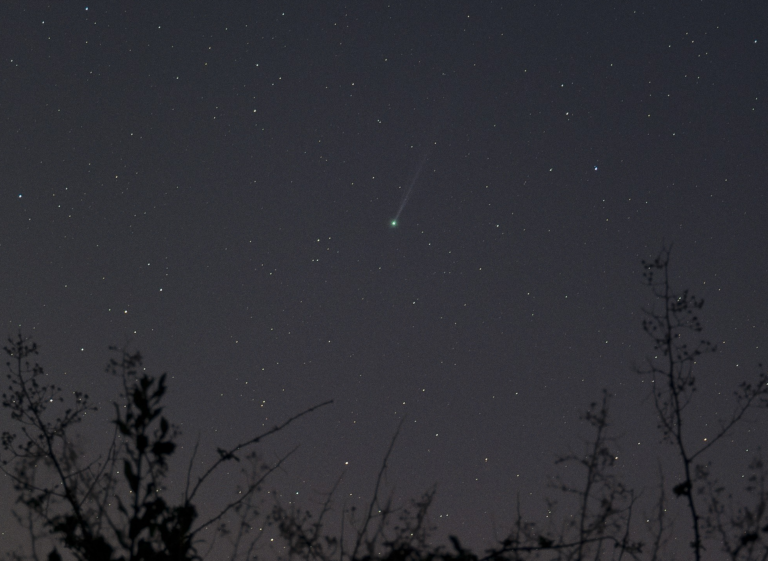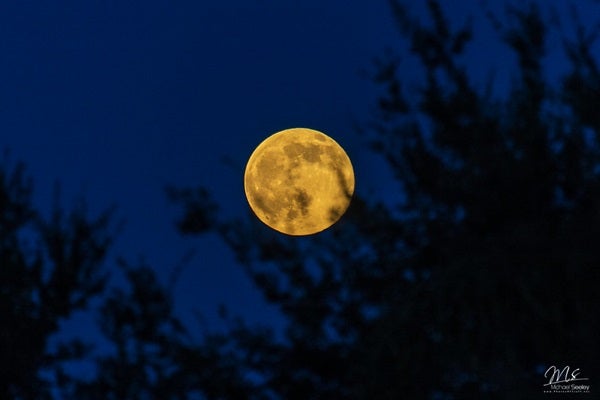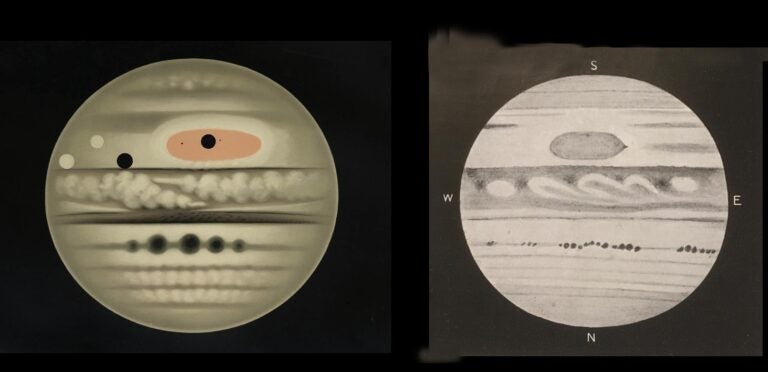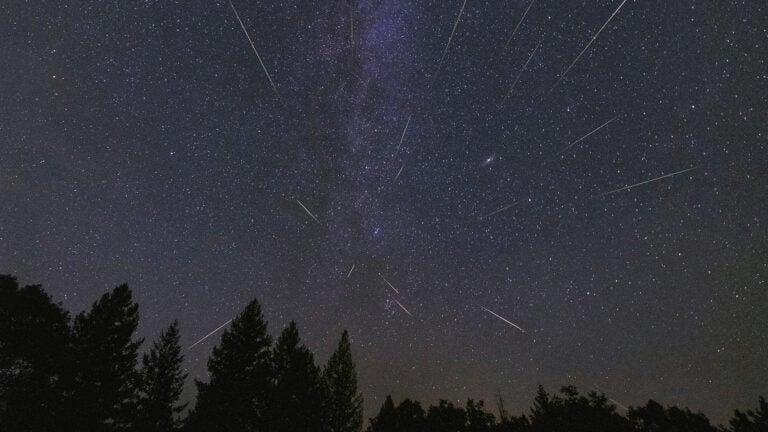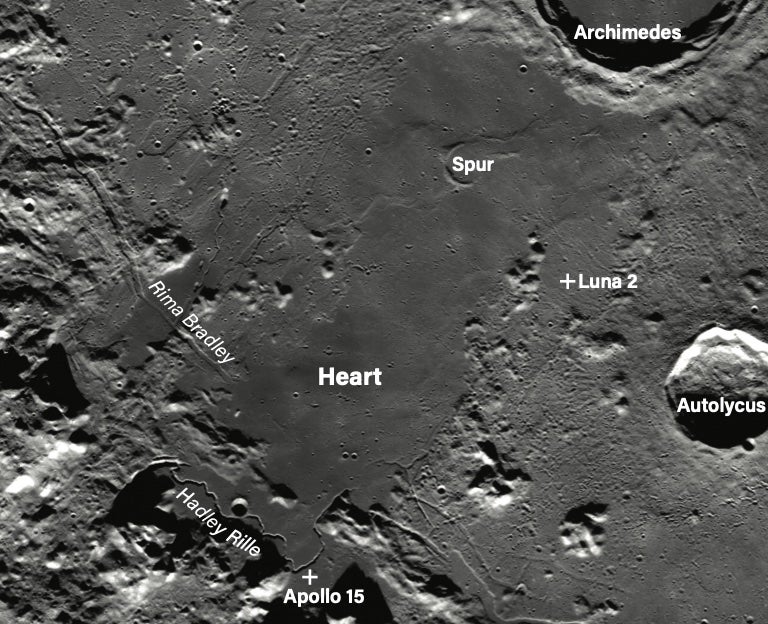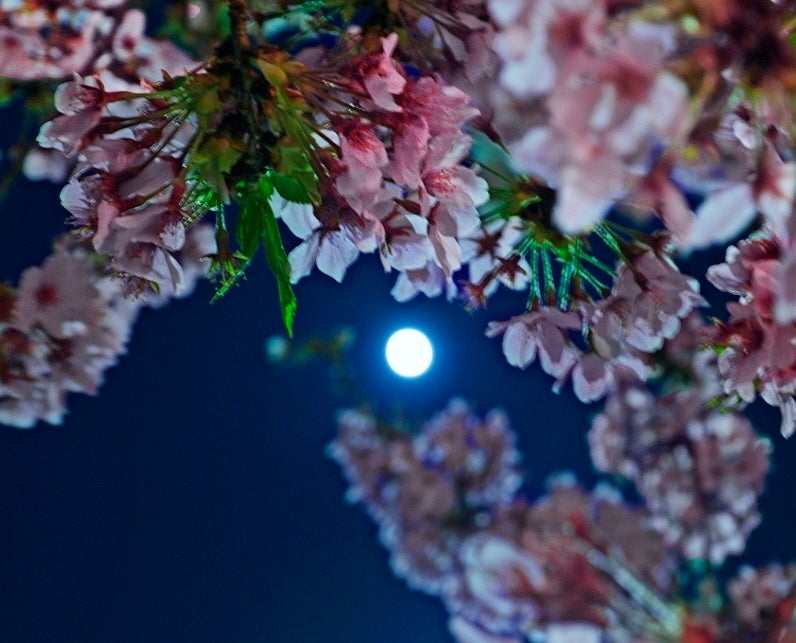

Sky This Week is brought to you in part by Celestron.
Friday, April 11
An hour after sunset, the bright planet Jupiter stands out in eastern Taurus, forming a V with the two tips of the Bull’s horns, Zeta (ζ) Tauri and Gamma (γ) Aurigae. Below Jupiter shines Aldebaran, the Bull’s alpha star, a magnitude 0.9 golden-hued red giant. And to Jupiter’s far lower right is the Pleiades (M45), a sparkling cluster of young stars visible to the naked eye and stunning to view under low magnification, such as binoculars or a telescope finder.
Over at Jupiter itself, use a telescope to watch the planet’s Great Red Spot crossing the disk this evening, reaching the center of the planet around 8:45 P.M. EDT. You can catch it at its best for an hour or two before or after this time as well, moving from east to west as the planet rotates.
Additionally, Jupiter’s moon Io treks in front of the planet, dragging its shadow with it. The event starts around sunset in the Midwest, as Io moves in front of the disk around 8:30 P.M. EDT. Its shadow appears just over an hour later, shortly before 9:40 P.M. EDT.
Io’s transit takes roughly two hours, ending as the moon slips away from the planet’s southwestern limb around 10:46 P.M. EDT. Its shadow again takes a little over an hour longer to reach the same point, disappearing around 11:52 P.M. EDT.
Jupiter’s other Galilean moons are visible as well: Europa and Callisto lie east of Jupiter, with the former closer to the planet. Ganymede is alone to the west of Jupiter until Io’s transit carries it to this side of the planet as well.
Sunrise: 6:27 A.M.
Sunset: 7:35 P.M.
Moonrise: 6:36 P.M.
Moonset: 5:48 A.M.
Moon Phase: Waxing gibbous (98%)
*Times for sunrise, sunset, moonrise, and moonset are given in local time from 40° N 90° W. The Moon’s illumination is given at 12 P.M. local time from the same location.
Saturday, April 12
The April Full Moon occurs at 8:22 P.M. EDT, shortly after our satellite rises in the east around sunset. Also called the Pink Moon, you might also see this particular Full Moon unofficially referred to as a “Micro Moon,” the opposite of a Super Moon. That’s because the Moon is nearing its apogee — the farthest point from Earth in its orbit. This makes the Moon appear slightly smaller than average in the sky, spanning roughly 29.5’ (as opposed to its average size of about 31’).
The Moon passes 0.3° south of the bright star Spica at 10 P.M. EDT. The two rise together, with the star slightly above our satellite. Spica is Virgo’s alpha star, shining at magnitude 1. It lies close to the ecliptic and is often occulted by the Moon, although that won’t happen tonight. The blue-white star is stunning through binoculars or a telescope, especially with the bright Moon nearby. In truth, Spica is a multiple-star system with its two brightest stars just 0.12 astronomical unit apart — one astronomical unit, or AU, is the average Earth-Sun distance of 93 million miles (150 million kilometers). But they are indistinguishable from each other in a telescope, combining into a single bright point of light for observers to enjoy.
Sunrise: 6:26 A.M.
Sunset: 7:35 P.M.
Moonrise: 7:37 P.M.
Moonset: 6:07 A.M.
Moon Phase: Full
Sunday, April 13
The Moon reaches apogee, the farthest point from Earth in its orbit, at 6:48 P.M. EDT. Our satellite will stand 252,460 miles (406,295 km) from our planet at that time. When it rises a little later than yesterday, it will still appear Full, now 99 percent illuminated and located in southeastern Virgo, to the lower left of Spica.
Now sinking in the west after sunset are the winter constellations of Orion and his hunting dogs, Canis Major and Canis Minor. Canis Major is easy to spot, anchored by the brightest star in the sky: Sirius, at magnitude –1.4. This star is often drawn as the Big Dog’s nose.
On the other side of Canis Major, near the dog’s tail, is 145 Canis Majoris, sometimes called the Winter Albireo. This pair of stars shows off lovely contrasting colors: One component is blue and the other is orange. They mimic the appearance of the star Albireo in Cygnus the Swan, which flies high on summer nights.
To catch the winter version as spring progresses, you’ll need to step outside in the few hours after sunset. Around 9 P.M. local daylight time, 145 CMa is still 20° high in the southwest, about 10° to the left (southeast) of Sirius in the sky as the constellation sets. The two stars of 145 CMa are easy to split even in a small, two-inch scope, and look even better in larger instruments.
Sunrise: 6:24 A.M.
Sunset: 7:37 P.M.
Moonrise: 8:37 P.M.
Moonset: 6:28 A.M.
Moon Phase: Full
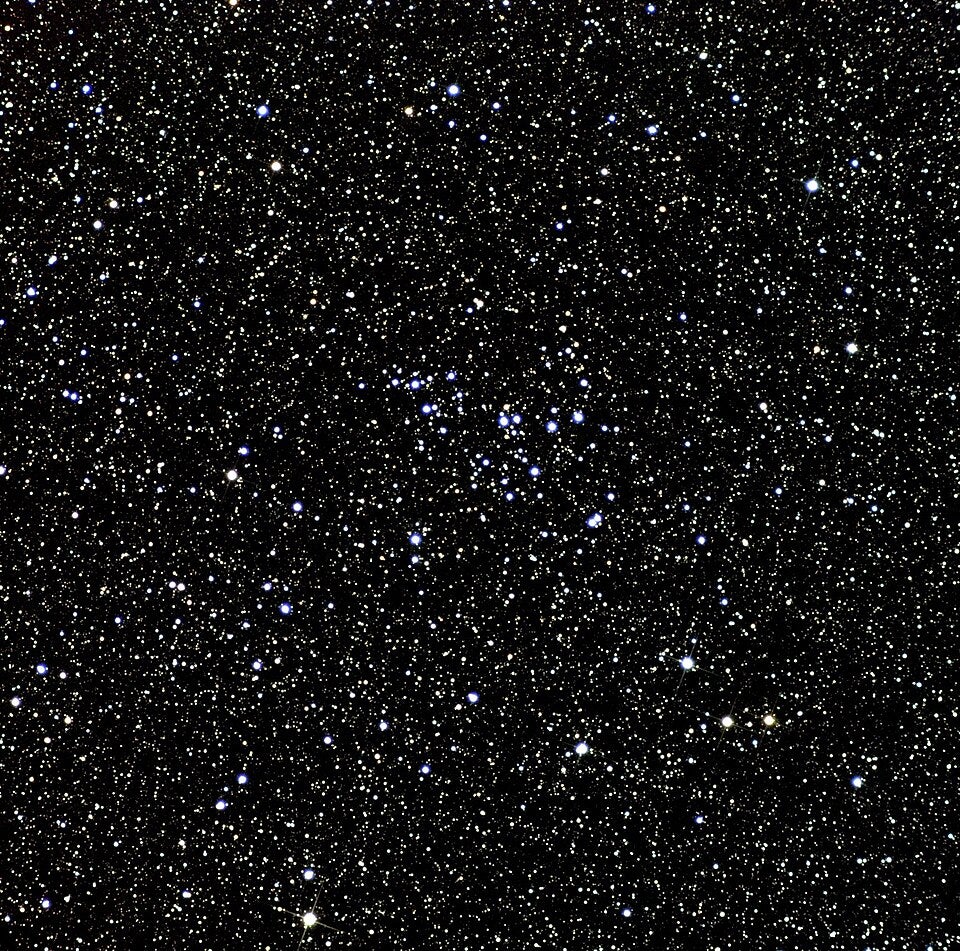
Monday, April 14
About 90 minutes before sunrise, the full Square of Pegasus is visible above the eastern horizon. This large asterism contains the stars Scheat, Markab, Algenib, and Alpheratz.
Just above and to the left of the Great Square as it is rising this morning is the small constellation Lacerta the Lizard, located between Andromeda and Cygnus. Although this little-known constellation contains no bright stars or Messier objects, it is home to a magnitude 6.4 open cluster: NGC 7243. You’ll find it about 2.7° southwest of 4th-magnitude Beta (β) Lacertae, or you can try dropping 8.3° south of brighter 3rd-magnitude Zeta (ζ) Cephei.
NGC 7243 spans about 20’ on the sky and is an estimated 2,800 light-years from Earth. Its young stars are roughly 100 million years old.
Sunrise: 6:23 A.M.
Sunset: 7:38 P.M.
Moonrise: 9:40 P.M.
Moonset: 6:51 A.M.
Moon Phase: Waning gibbous (97%)
Tuesday, April 15
The distant planet Uranus is still visible, though it will soon be lost in twilight at the end of the month. For now, the ice giant sets within 2.5 hours of the Sun. Tonight, Uranus stands 0.9° due north of a magnitude 6.8 field star in Taurus, making it easier than usual to find.
Shining at magnitude 5.8, Uranus is best seen with binoculars or a telescope. To find it, first locate the Pleiades cluster in western Taurus, now sinking in the west after sunset. Center the Pleiades in your eyepiece, then slide about 4.5° south to land on 13 and 14 Tauri, a pair of 6th-magnitude stars that are oriented in an east-west line. From this pair, slide 3° southwest and you’ll find another pair of stars, with 6th- and 7th-magnitude components.
Tonight, Uranus — brighter than either of these two stars — is just under a degree due north of the westernmost star in this duo. The planet’s disk spans 3” and may appear grayish-blue. Note that Uranus is also 1° due east of a magnitude 6.5 field star.
Sunrise: 6:21 A.M.
Sunset: 7:39 P.M.
Moonrise: 10:43 P.M.
Moonset: 7:19 A.M.
Moon Phase: Waning gibbous (94%)
Wednesday, April 16
Mercury passes 0.7° south of Neptune at 3 P.M. EDT; the two planets are briefly visible in the early-morning sky, so let’s try to catch them in the short time between when they rise and the Sun follows.
Half an hour before sunrise, Neptune and Mercury are just 4° high in the east. Mercury is magnitude 0.6, standing to the lower left of much brighter, higher Venus, which is 11° high and magnitude –4.7. If you can spot Mercury through a telescope, you’ll see that the tiny planet’s disk — some 9” wide — is 37 percent lit, showing off a crescent phase.
Neptune is located just north of Mercury, close enough that both should be visible in a single telescopic field of view. The ice giant is a faint magnitude 7.8 and will likely be difficult to pick out of the brightening sky. Additionally, 3.8° west of Mercury is magnitude 1.2 Saturn, which may also be visible in a telescope, with its rings stretching to either side. These views will be challenging in the oncoming dawn, and you’ll need to make sure to put away your optics at least several minutes before the Sun rises from your location, which may differ from the time given below.
This evening at 6 P.M. EDT, the planet Mars reaches aphelion, the farthest point from the Sun in its orbit. At that time, its distance from our star will be 154.9 million miles (249.3 million km). An hour after sunset, you’ll find the Red Planet still high in the southwest, now in western Cancer the Crab. Shining at magnitude 0.7, it’s an easy-to-find light just to the upper left of Castor and Pollux in Gemini. Through a telescope, the martian disk is just 7” across — now smaller in apparent size than Mercury, thanks to its distance from Earth.
Over the next few weeks, Mars will quickly approach central Cancer, which houses the lovely naked-eye Beehive Cluster. The two will mingle late in the month, so make sure to check back then!
Also this evening, at 7 P.M. EDT, the Moon passes 0.4° south of the red giant Antares in Scorpius. The two rise shortly before midnight and will be visible in the early-morning sky tomorrow, so keep reading for more details.
Sunrise: 6:20 A.M.
Sunset: 7:40 P.M.
Moonrise: 11:45 P.M.
Moonset: 7:52 A.M.
Moon Phase: Waning gibbous (88%)
Thursday, April 17
Around 3 A.M. local daylight time this morning, the heart of Scorpius, the star Antares, stands some 20° high in the south. To its lower left is the bright waning gibbous Moon, now just over 80 percent lit.
After passing less than a degree due south of Antares yesterday evening, the Moon is now about 5° southeast of the star. The two stand together in a rich region of the Milky Way along the galactic plane and near the center of our galaxy, which lies just to their left in Sagittarius, near the spout of the Teapot asterism.
First-magnitude Antares is a deep red similar to the planet Mars, which is why its name means “rival of Mars.” The color arises from the aging star’s temperature of 3,600 kelvins — much lower than our Sun’s temperature of nearly 5,800 K. Despite this, however, Antares is some 10,000 times brighter than the Sun, thanks to its mass of more than 10 times our star’s.
Antares is a binary system that contains a magnitude 5.5 companion some 3” away. When viewed together, contrast from the red color of Antares often makes the fainter star appear green to the human eye, although in truth it is a hot blue-white. Splitting this pair depents on your location, and requires good seeing and a relatively large scope — challenge yourself to see whether your conditions are right for doing so.
Sunrise: 6:18 A.M.
Sunset: 7:41 P.M.
Moonrise: —
Moonset: 8:33 A.M.
Moon Phase: Waning gibbous (81%)
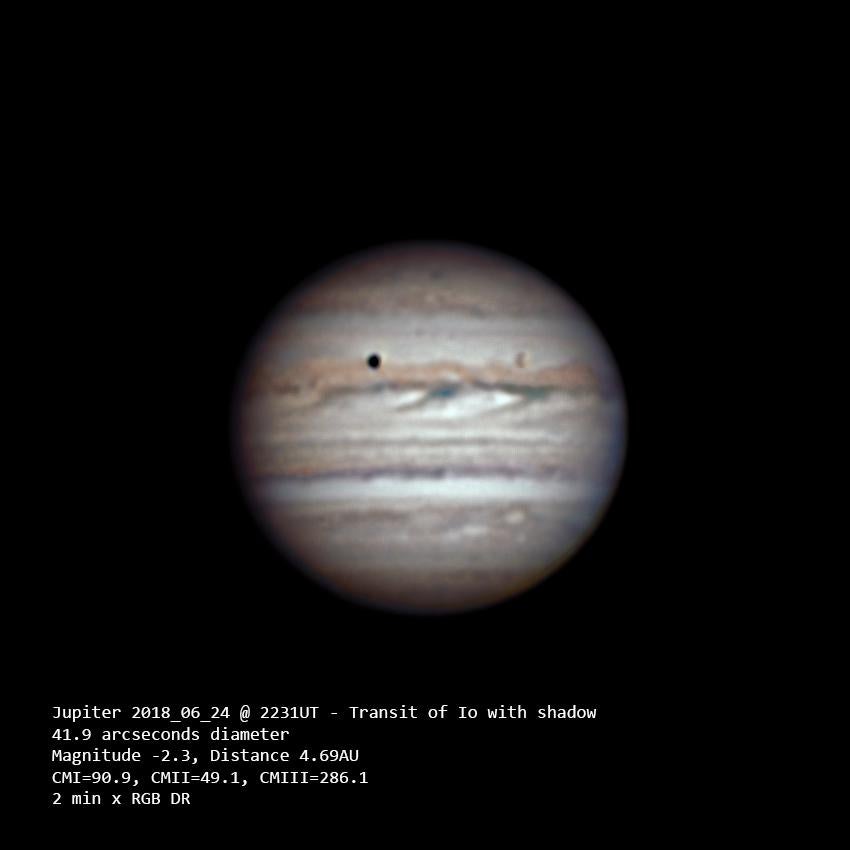
Friday, April 18
If you missed the action earlier in the week, Jupiter’s volcanic moon Io again transits the face of the gas giant tonight along with its shadow. The beginning of the event is visible in the eastern half of the U.S., while later stages are only observable from the western half of the country, as Jupiter sets before their journey is complete.
Jupiter is still shining between and below the horns of Taurus the Bull in the evening sky, slowly sinking in the west after sunset. It’s the brightest point of light in Taurus, directly above the star Aldebaran. Early in the evening from the eastern U.S., Jupiter is flanked by two of its Galilean moons on each side: Ganymede (closest) and Callisto to the west, and Europa and Io (closest) to the east.
Io begins a transit at the southeastern limb of Jupiter at 10:35 P.M. EDT. The moon takes a little over two hours to transit, ending its journey just before 10:50 P.M. MDT — note the time change, as the planet is setting in the Midwest. Its shadow transit begins at 10:36 P.M. CDT, after Jupiter has disappeared below the horizon in the Eastern time zone. The shadow takes a similar amount of time to cross the face of the planet, finally disappearing from the southwestern limb around 10:50 P.M. PDT, when Jupiter has set for all but those on the U.S. West Coast.
Sunrise: 6:17 A.M.
Sunset: 7:42 P.M.
Moonrise: 12:43 A.M.
Moonset: 9:23 A.M.
Moon Phase: Waning gibbous (73%)

